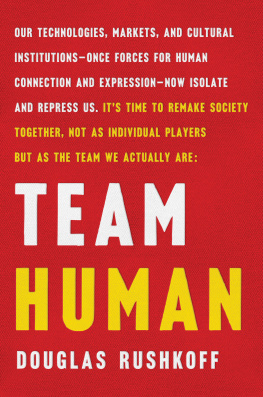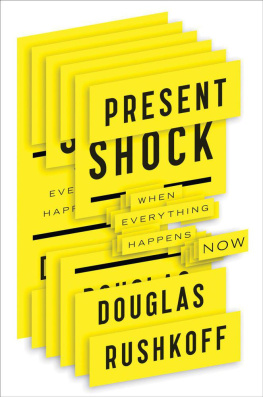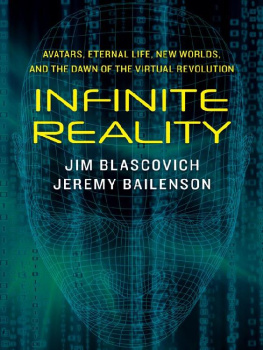Copyright
2010 Douglas Rushkoff.
Ten percent of the authors proceeds are donated to the WikiMedia Foundation and Archive.org.
Original line drawings by Leland Purvis.
Visit our website at www.orbooks.com
First printing 2010.
All rights reserved. No part of this book may be reproduced or transmitted in any form or by any means,
electronic or mechanical, including photocopy, recording, or any information storage retrieval system,
without permission in writing from the publisher, except brief passages for review purposes.
Library of Congress Cataloging in Publication Data:
A catalog record for this book is available from the Library of Congress
British Library Cataloging in Publication Data:
A catalog record for this book is available from the British Library
Typeset by Wordstop, Chennai, India
Printed by BookMobile, USA
Paperback ISBN 978-1-935928-15-7
Ebook ISBN 978-1-935928-16-4
10 9 8 7 6 5 4 3 2 1

Cover
I. TIME
Do Not Be Always On
The human nervous system exists in the present tense. We live in a continuous now, and time is always passing for us. Digital technologies do not exist in time, at all. By marrying our time-based bodies and minds to technologies that are biased against time altogether, we end up divorcing ourselves from the rhythms, cycles, and continuity on which we depend for coherence.
The beauty of the early net was its timelessness.
Conversations took place on bulletin boards over periods of weeks or months. People got onto the Internet by connecting their computers to phone lines, and then dialing in through a modem to a server. All this not only took time, but made going online an intentional act. Most of life was spent offline, and a few special moments or even hours in the evening were spent online, exploring files and participating in discussions.
Since everyone was logging in from different locations at different times, most online experiences were what we called asynchronous. This meant that, unlike a regular conversation or phone call where we exist together in the same moment and speak back and forth in real time, these online conversations were more like passing letters back and forth. You would go online, find the conversation you were participating in, and then see all the posts that occurred between one evening and the next. After reading everyones responses, you would then decide whether you wanted to add somethingand either compose it on the spot, or write the response offline and then come back and paste it in later or even the next day.
These discussions took on the quality of playing a chess game by mail. Nothing was rushed. If anything, because our conversations were asynchronous, we had the luxury of deeply considering what we said. The net became a place for doing the kind of deliberation and contemplation that couldnt happen in the harried real world of jobs, kids, and automobiles. Because online activities did not have to occur in real time, we ended up having all the time in the world. One actually thought before respondingsometimes a whole day.
This fostered a depth of engagement and a collaborative spirit that many of us had never experienced before. Even a heated exchange was pursued with finesse, combatants having the time to cool down and consider the best retort instead of simply lashing out. The point of conversation became the conversation itself, and the modeling of a new form of approaching problems as a group. No wonder then, that so many people saw the Internet as panacea to the worlds many conflicts and intractable divides.
It shouldnt surprise us that this deliberate, highly sequential mode of behavior is utterly consistent with the programs and code underlying the digital universe. Digital technologies are biased away from time, and toward asynchronicity. Their operating systems were designed this way because, in most respects, computers think much faster than people. They can give themselves new instructions almost instantaneously. But they also need to be able to wait as long as necessary for instructions from a person typing through a keyboard. So programmers decided that computers shouldnt live in time at all. (Yes, there are clocks running in the background on all computers, but they take their orders regardless of the passage of time.)
Instead of operating in time, computers operate from decision to decision, choice to choice. Nothing happens between the moments I type any two letters on the keyboard. As far as the computer is concerned, this word is the same as this one, even though I took one second to produce the first, and a full minute to produce the second. The machine waits for the next command, and so on, and so on. The time between those commands can be days, or a millisecond.
Because computer code is biased away from continuous time, so too are the programs built on it, and the human behaviors those programs encourage . Everything that we do in the digital realm both benefits and suffers from its occurrence outside time.
Maybe thats why the nets first true killer app was email. At first, email did not replace the letter so much as it replaced the phone call. Instead of having to find and catch a real person at home (cell phones were not yet very common), email found a person when he or she wanted to be found. Email was an activity one went and did, usually on a daily or twice-daily basis. (Before and after work, in most cases!)
Unlike the phone, which interrupts our day by unexpectedly ringing whenever someone wants to reach us, email was retrieved when we wanted to see it. And we were free to respond in our own time, on our own conditions. If we didnt have a response at the ready, we could come back later.
The underlying asychronous quality of email and conferencing was much more obvious to us back then, because we all saw the way these tools really worked. Back then, phone calls still cost money, as did our access time. So our computers generally went online, logged into a server, downloaded everything we were supposed to see, and then logged off again. We did most of our responding while we werent even online. Then, the next time we went online, our computers would upload the email and posts we had written.
Was it slower? Perhaps. But it was also a more accurate reflection of the way the technologies work, and their bias away from real-time communication. Their strength was never their relationship to the now, but their ability to slow down or break up the now.
The interactive urge itselfeven before computers came into our liveswas consistent with this desire to break time. The first interactive device most of us ever used was the remote control. More than simply allowing us to change channels at the end of a TV program, the remote control gave us the ability to change channels during a TV program. The remote control allowed us to deconstruct the narrative of a show, or even a commercial.
Until interactivity, we were defenseless emotional targets for the advertiser, who could use a linear story to put us in a state of vulnerability. Think of almost any television commercial: A person gets in terrible trouble, the product gets her out. A girl gets a pimple before the prom. She tries all sorts of things to get rid of it, making matters worse. Just when it looks like all is lost, she finds the miracle cream. It works, boyfriend shows up, happy prom girl. The continuous narrative arc is used to draw the audience into a state of tension. Only the storytellerthe advertiserhas the way out. To be released from tension, we must accept the storytellers answermeaning the advertisers product. We may have understood that the people making us anxious were not our friendsthat the stuff on television is called programming for a reason. But we were relatively powerless to do anything about it other than not watch at all.









